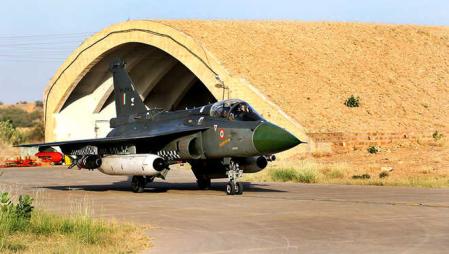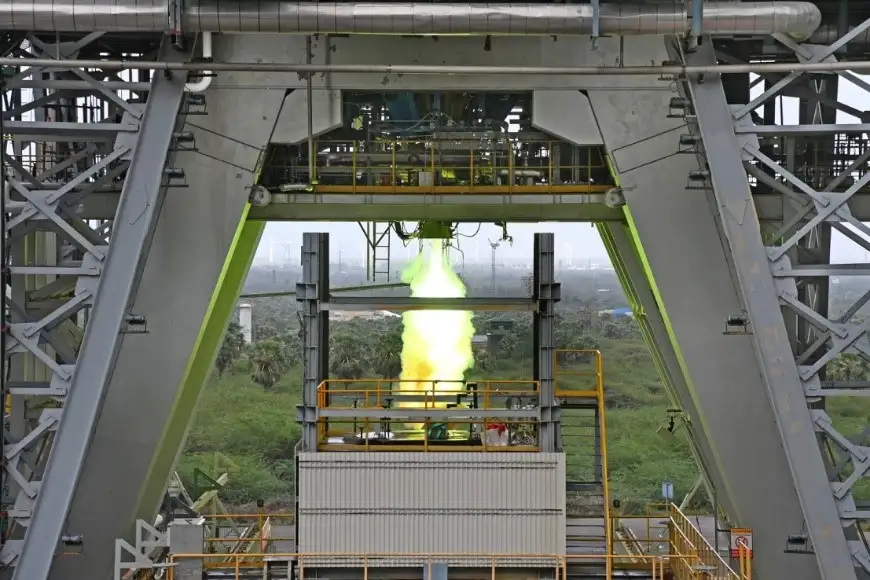SOURCE: RAUNAK KUNDE / NEWS BEAT / IDRW.ORG

A senior Indian Air Force (IAF) official, speaking to idrw.org, has downplayed the strategic impact of Pakistan’s potential acquisition of China’s J-35A stealth fighter jets. The official emphasized that the addition of these aircraft to the Pakistan Air Force (PAF) inventory is unlikely to alter the balance of firepower in the region or provide Pakistan with a significant edge to conduct raids inside Indian territory.
The official pointed to the limited number of J-35A jets Pakistan is likely to procure, stating that the quantity would be “insignificant” in shifting the regional air power dynamics. This assessment draws parallels with Pakistan’s earlier acquisition of approximately 20 J-10CE fighter jets from China. During a recent aerial clash with the IAF, the J-10CEs, equipped with PL-15E air-to-air missiles, failed to achieve any significant success against Indian jets. The official noted that most of the PL-15E missiles fired by the PAF’s J-10CEs were ineffective, underscoring the IAF’s superior tactics, technology, and preparedness.
Continue readingSOURCE: AFI

In a stunning display of aerial dominance, the Indian Air Force (IAF) has reportedly destroyed at least nine Pakistani aircraft during a covert operation codenamed “Operation Sindoor,” according to reliable IAF sources close to Shiv Aroor, NDTV. The operation, shrouded in strategic secrecy, has sent shockwaves through the region, with confirmed reports indicating that among the losses sustained by the Pakistan Air Force (PAF) are Mirage and JF-17 fighter jets.
Sources within the IAF have confirmed that the operation targeted key Pakistani air assets, with the IAF leveraging its superior tactical capabilities to neutralize the threats. The Mirage, a versatile multirole fighter, and the JF-17, a lightweight, single-engine jet developed jointly by Pakistan and China, were specifically identified among the destroyed aircraft. While the exact circumstances of the engagements remain classified, the IAF’s precision and operational efficiency have been highlighted as critical to the mission’s success.
Continue readingSOURCE: AFI
In a shocking revelation that has sent ripples across Pakistan and beyond, Pakistani security expert Imtiaz Gul has claimed in a viral social media video that the Pakistan Air Force’s (PAF) Nur Khan Airbase in Rawalpindi is effectively under American control. The video, which has garnered widespread attention, quotes Gul stating, “Pakistan’s Nur Khan Airbase is reportedly under American control — even Pak Army officers aren’t allowed to interfere.” This explosive allegation has raised serious questions about Pakistan’s sovereignty over one of its most critical military installations.
Gul’s claims suggest that Pakistan Army officials are “not authorised” to exercise full control over the airbase, hinting at operational agreements or restrictions tied to joint operations or visits involving American forces. He further alleged that American aircraft have been repeatedly sighted at the airbase, with a notable lack of transparency regarding their cargo. “What are these planes carrying? Why is there no clarity?” Gul can be heard questioning in the video, fueling speculation about foreign influence over Pakistan’s military infrastructure.
Continue readingSOURCE: AFI

In a significant development for Pakistan’s air defense modernization efforts, the Pakistan Air Force (PAF) has reportedly approached Turkish defense company Aselsan to acquire the ALP-300G, a next-generation S-Band Active Electronically Scanned Array (AESA) long-range radar. This move comes in the wake of growing dissatisfaction within the PAF with the performance of Chinese-supplied air defense radars, which have reportedly failed to meet operational expectations in detecting and tracking modern threats effectively.
The ALP-300G, developed by Aselsan, is a state-of-the-art radar system designed for long-range early warning and air defense. It boasts advanced AESA and digital beamforming technology, enabling it to detect and track a wide range of targets, including air-breathing threats, ballistic missiles, anti-radiation missiles, and low Radar Cross Section (RCS) targets like stealth aircraft and drones, at extended ranges. The radar’s Multi-Channel Digital Beam Forming architecture supports simultaneous multi-beam operations, paving the way for multi-function and multi-mission capabilities. It can also perform weather information analysis to optimize detection and tracking performance, making it a highly mobile and standalone system with integrated radar, command-and-control, communication, and power systems.
Continue readingSOURCE: AFI

Ukraine executed a daring and unprecedented drone attack, codenamed “Operation Spider’s Web,” targeting Russian strategic aviation assets across multiple airbases, including Belaya in Siberia’s Irkutsk region, Olenya in Murmansk, Dyagilevo in Ryazan, and Ivanovo. The operation, meticulously planned over 18 months by Ukraine’s Security Service (SBU), reportedly destroyed or damaged over 40 Russian aircraft, including nuclear-capable Tu-95 “Bear” and Tu-22M3 “Backfire” strategic bombers, as well as A-50 airborne early warning and control aircraft.
This audacious strike, conducted over 4,000 kilometers from Ukraine’s border, has sent shockwaves through global military circles and exposed critical vulnerabilities in airbase defense, particularly the lack of hardened aircraft shelters. For the Indian Air Force (IAF), this attack serves as a stark reminder of the urgent need to bolster its airbase infrastructure with Next Generation Hardened Aircraft Shelters (NGHAS) to protect its own high-value assets.
Continue readingSOURCE: UNI

Pakistan is grappling with a severe water crisis, particularly in Punjab province, as water levels in the Indus River system have dropped significantly. The crisis comes at a critical time, coinciding with the Kharif sowing season and an ongoing heatwave. According to the Indus River System Authority (IRSA), water availability as of June 2 has decreased by over 10% compared to the same time last year, with key reservoirs like Tarbela and Mangla dams nearing critical levels. The delayed arrival of the Southwest Monsoon, expected only by the end of June, is compounding irrigation challenges for farmers already under stress.
The situation has worsened following a sudden reduction in the Chenab River’s inflow, attributed to India’s suspension of water sharing under the Indus Waters Treaty. Islamabad claims this move follows the April 22 terror attack in Pahalgam, which India linked to cross-border militancy. The Indus Waters Treaty, signed in 1960, allocates 80% of water from the Indus system to Pakistan, while India retains 20%. With the treaty now in abeyance, India has also stopped sharing vital flood data, raising fears of unanticipated monsoon flooding in low-lying Pakistani regions.
Continue readingSOURCE: PTI

Reliance Infrastructure Ltd, the flagship company of Anil Ambani’s Reliance Group, is targeting ?3,000 crore from the export of 155 mm ammunition and aggregates by the end of financial year 2027, sources said.
In the current year itself, the company is estimated to export ?1,500 crore of large calibre ammunition. Reliance Infrastructure has already clocked exports of up to ?100 crore of artillery ammunition and aggregates and is aiming to be among the top three exporters of defence equipment in India, sources aware of the matter said.
Continue readingSOURCE: ISRO

ISRO commenced a series of performance evaluation tests in March 2025 of the Semicryogenic engine Power Head Test Article (PHTA) that comprises all the engine systems except the thrust chamber. These tests were planned to validate the design of the propellant feed system, including the low-pressure and high-pressure turbo-pumps, the pre-burner, start system and control components. On May 28, 2025, the Power Head Test Article (PHTA) underwent a third hot test at the ISRO Propulsion Complex (IPRC), Mahendragiri, that was aimed at validating the engine’s ignition and start-up sequence and to derive optimum sequence for the integrated engine.
During the test, the engine was successfully ignited and operated up to 60% of its rated power level, demonstrating stable and controlled performance throughout the firing. The PHTA has earlier undergone two hot tests.
Continue readingSOURCE: PTI

Prime Minister Narendra Modi will chair a meeting of the Union Council of Ministers on Wednesday, the first after India’s punitive military action against Pakistan under Operation Sindoor, launched in response to the Pahalgam terror attack.
According to PTI, the ministers are likely to be given details of the operation, which is also expected to figure in the ruling BJP’s programmes starting next week to mark the first anniversary of the Modi government in its third term.
Continue readingSOURCE: IANS

Sixteen Maoists, including two hardcore insurgents, have surrendered in Sukma, Chhattisgarh, marking a significant setback for the Maoist movement in the region. Among them, a woman and a man carried individual bounties of Rs 8 lakh, while others had varying rewards, bringing the total to Rs 25 lakh. The surrender took place on Monday before senior police and CRPF officers in Sukma district.
Superintendent of Police Kiran G Chavan said that the Maoists were influenced by the Chhattisgarh government’s ‘Niyad Nellnar’ initiative, which aims to promote development in remote villages.
Continue readingSOURCE: IANS

Errol Musk, father of the world’s richest man and American billionaire Elon Musk, on Monday called for an end to the miseries of Kashmiris living under the spectre of terrorism, saying ‘if it is Pakistan causing the trouble, something needs to be done about it’.
In an interaction with IANS, the 79-year-old South African patriarch of the Musk family sympathised with Kashmiris living in a hostile environment and said, “You cannot make ordinary people suffer like this… you’ve got to make a plan and put an end to it.”
Continue readingSOURCE: PTI

Basic military training will be imparted to students from Class 1 in Maharashtra in a move to instil a sense of patriotism, discipline and promote a habit of regular physical exercise among them, state School Education Minister Dada Bhuse said.
Retired soldiers will be roped in for training the students, he informed. “A decision has been taken to give basic-level military training to students from Class 1. This will help inculcate love for the country, encourage habits like doing physical exercise regularly and discipline that will benefit the students,” Bhuse said.
Continue readingSOURCE: PTI

The tourism sector in Kashmir has started the long journey to normalcy as tourists, though in smaller numbers, are returning to the valley after the Pahalgam terror attack dealt a big blow to the industry. Groups of tourists, especially from states like Maharashtra and Gujarat, are reaching the famous tourist resorts of Gulmarg and Pahalgam, infusing hopes of a gradual turnaround in the sector.
Though in marginal numbers, tourist arrivals have led to some sort of activity in the sector, which was considered almost dead in the days following the April 22 attack in Baisaran meadows of Pahalgam in which 25 tourists and a local were killed.
Continue readingSOURCE: IDRW.ORG

Turboprop aircraft manufacturer ATR is considering establishing a manufacturing facility in India, provided it aligns with business and industrial objectives, according to Jean-Pierre Clercin, ATR’s head for the Asia Pacific region. In an interview with Business Standard on Sunday, Clercin highlighted the potential for India to become a key part of ATR’s global strategy, leveraging the existing investments of its parent companies, Airbus and Leonardo.
ATR, a joint venture between European aerospace giants Airbus and Leonardo, currently operates manufacturing facilities in France and Italy. The company, known for its fuel-efficient turboprop aircraft like the ATR 42 and ATR 72, sees India as a promising market due to its growing aviation sector and government initiatives like UDAN, which aim to boost regional connectivity.
Continue readingSOURCE: IDRW.ORG

The Council for Scientific and Industrial Research (CSIR) has unveiled a cutting-edge non-destructive evaluation (NDE) framework that utilizes ultrasonic guided waves to detect damage in aircraft components. Developed by researchers at CSIR’s National Aerospace Laboratory (NAL), this innovative technology promises to revolutionize aircraft maintenance by offering a faster, more cost-effective, and reliable method compared to conventional techniques.
The new framework is set to enhance safety and efficiency in both civil aviation and military operations. By enabling precise damage detection, it supports routine maintenance and life-extension programs for aircraft, ensuring operational reliability and safety. The technology’s applications extend beyond commercial aviation, offering significant benefits to the armed forces for day-to-day assessments and extending the service life of critical assets.
Continue reading